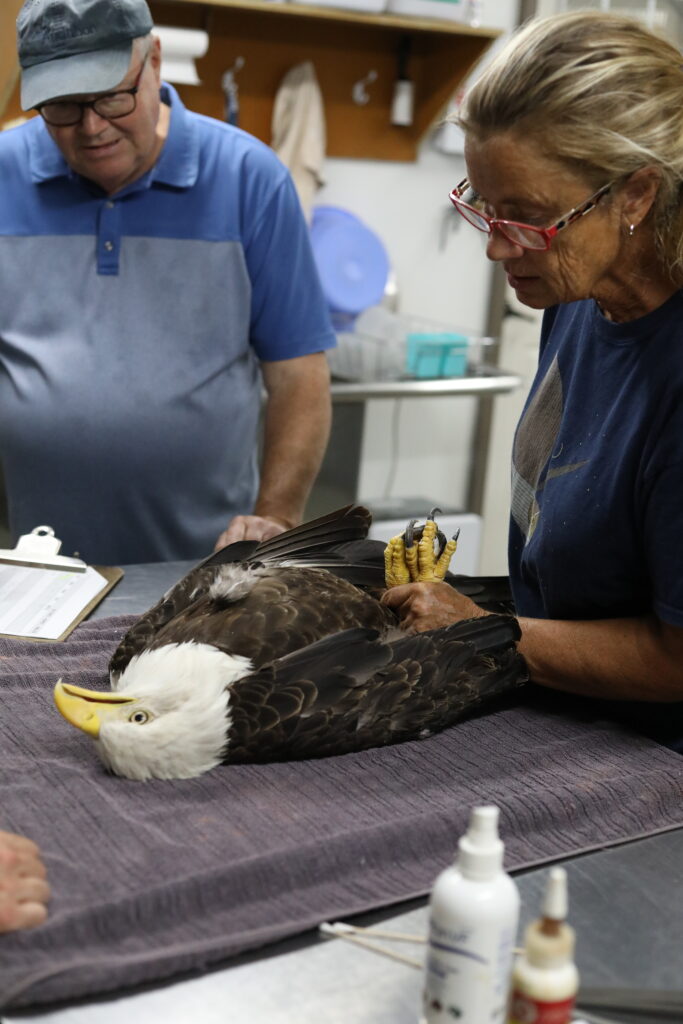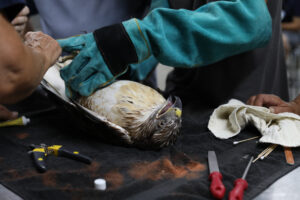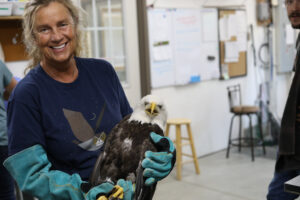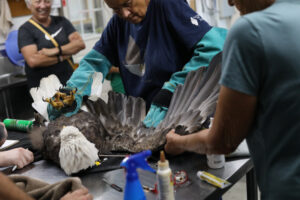Back to School: Raptor Style
article by Ell Kinsey, Raptor Care Specialist
Next time your kids don’t want to see the doctor, remind them that even Fontenelle Forest’s raptors have to brave their back-to-school physicals.
In early August, the raptor team buckled down to give each bird a thorough exam. This article provides a behind-the-scenes look at what these examinations entail.
First, the bird is cast—meaning a handler restrains the bird in a manner to ensure everyone’s safety, especially that of the raptor. Once an accurate weight of the raptor is recorded, the team conducts a physical examination, assessing the condition of the feathers, eyes, feet, beak and wings. Birds tend to mask illness, so clues like dramatic weight drops, or discharge from the eyes or nostrils, can help caretakers identify sickness and intervene.

Denise Lewis, Director of Programs, and Bob Wells, raptor volunteer, inspects a bald eagle’s talons during its annual physical examination.
Feathers are obviously unique to birds, but they come with their own set of complications. When a new feather—called a pin feather—starts to grow, the shaft obtains its own blood supply. The pin feather grows, covered in a waxy sheath that the bird will preen away once the feather is done growing, at which point blood will no longer circulate through the feather. During the time when there is a blood supply, it’s imperative that the pin feather not break. A broken shaft acts as a siphon. The bird can lose blood very quickly and ultimately bleed out. Should a “blood feather” break, the feather must be removed, either by the bird or a caretaker. The skin closes at the base, stopping the hemorrhage. The birds who live in the Raptor Woodland Refuge due to previous wing injuries, tend to develop blood feathers during this time of year. Again, making the examinations vital to keeping our raptors healthy.
In the wild, birds of prey are constantly on the move, landing on a variety of perches and eating a variety of prey. These actions keep the beak and talons filed down. Because the Forest’s raptors can’t survive in the wild due to their injuries or upbringing sustained prior to coming to the Forest, their beaks can grow to an unhealthy curve and their talons can catch and tear upon perching. For this reason, our birds’ beaks and talons are manually trimmed and filed down, sometimes several times a year. During the most recent round of physicals, many of the raptors required at least a talon trim.
Finally, the birds received their only vaccine, which is to protect against West Nile Virus (WNV). Birds are more susceptible to this than humans, and the species of mosquito that tends to carry WNV reaches Nebraska around August. Bob Wells, a raptor volunteer and a former anesthesiologist, is well-versed in dosing medication. Denise Lewis, Director of Programs, has loads of experience giving birds vaccines, which the raptors received in their breast muscle.
Nothing overtly concerning was found during the check-ups, though two owls will visit a veterinarian eye specialist in the next month to assess for possible cataracts.
It’s important to recognize that while these exams can cause a raptor stress, the team undergoes much preparation to ensure the process is as efficient as possible. Each exam averaged less than five minutes.
Each of our 23 resident raptor ambassadors was swiftly returned to their respective enclosures in the Raptor Woodland Refuge once their examination was complete.







